Rhynchocephalia
Rhynchocephalia (/ˌrɪŋkoʊsɪˈfeɪliə/; lit. 'beak-heads') is an order of lizard-like reptiles that includes only one living species, the tuatara (Sphenodon punctatus) of New Zealand. Despite its current lack of diversity, during the Mesozoic rhynchocephalians were a diverse group including a wide array of ecologies. The oldest record of the group is dated to the Middle Triassic around 238 to 240 million years ago, and they had achieved a worldwide distribution by the Early Jurassic.[1] Most rhynchocephalians belong to the group Sphenodontia ('wedge-teeth'). Their closest living relatives are lizards and snakes in the order Squamata, with the two orders being grouped together in the superorder Lepidosauria.
| Rhynchocephalians | |
|---|---|
.jpg.webp) | |
| Fossil of Vadasaurus, a rhynchocephalian from the Late Jurassic of Germany | |
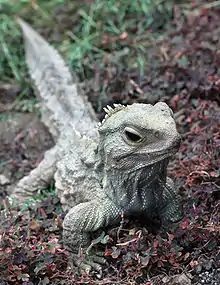 | |
| The tuatara, the only living rhynchocephalian | |
| Scientific classification | |
| Domain: | Eukaryota |
| Kingdom: | Animalia |
| Phylum: | Chordata |
| Class: | Reptilia |
| Superorder: | Lepidosauria |
| Order: | Rhynchocephalia Günther 1867 |
| Type species | |
| Sphenodon punctatus Gray, 1842 | |
| Families | |
| |
Many of the niches occupied by lizards today were held by sphenodontians during the Triassic and Jurassic, although lizard diversity began to overtake sphenodontian diversity in the Cretaceous, and they had disappeared almost entirely by the beginning of the Cenozoic. While the modern tuatara is primarily carnivorous, there were also sphenodontians with omnivorous (Opisthias), herbivorous (Eilenodontinae), and durophagous (Oenosaurus) lifestyles. There were even several successful groups of aquatic sphenodontians, such as pleurosaurs and Ankylosphenodon.[2]
History of discovery
Tuatara were originally classified as agamid lizards when they were first described by John Edward Gray in 1831. They remained misclassified until 1867, when Albert Günther of the British Museum noted features similar to birds, turtles, and crocodiles. He proposed the order Rhynchocephalia (meaning "beak head") for the tuatara and its fossil relatives.[3] In 1925 Samuel Wendell Williston proposed the Sphenodontia to include only tuatara and their closest fossil relatives.[4] Sphenodon is derived from Greek σφήν sphen 'wedge' and ὀδούς odous 'tooth'.[5][6][7] Many disparately related species were subsequently added to the Rhynchocephalia, resulting in what taxonomists call a "wastebasket taxon". These include the superficially similar (both in shape and name) but unrelated rhynchosaurs, which lived in the Triassic.[4] These were resolved after use of computer based cladistics, which showed the core sphenodontian grouping to be monophyletic.[8]
Classification and anatomy
_601758.jpg.webp)
Sphenodonts, and their sister group Squamata (which includes lizards, snakes and amphisbaenians), belong to the superorder Lepidosauria, the only surviving taxon within Lepidosauromorpha.
Squamates and sphenodontians have a number of shared traits (synapomorphies), including fracture planes within the tail vertebrae allowing caudal autotomy (loss of the tail-tip when threatened), transverse cloacal slits, an opening in the pelvis known as the thyroid fenestra, the presence of extra ossification centres in the limb bone epiphyses, a knee joint where a lateral recess on the femur allows the articulation of the fibula, the development of a sexual segment of the kidney, and a number of traits of the feet bones, including a fused astralago-calcaneun and enlarged fourth distal tarsal, which creates a new joint, along with a hooked fifth metatarsal.[9]
Like some squamates, the tuatara retains a parietal eye, which has been lost in the other groups of extant reptiles, the turtles and archosaurs.[10] Rhynchocephalians are distinguished from squamates by a number of traits, including the retention of gastralia (rib-like bones present in the belly of the body, ancestrally present in tetrapods and also present in living crocodilians).[11] The complete lower temporal bar (caused by the fusion of the jugal and quadtrate/quadratojugal bones) of the tuatara, often considered a primitive feature, is actually a derived feature among sphenodontians, with the most primitive lepidosauromorphs and rhynchocephalians having an open lower temporal fenestra.[12][13] Unlike squamates, but similar to the majority of birds, the tuatara lacks a penis. This is a secondary loss, as a penis or squamate-like hemipenes were probably present in the last common ancestor of rhynchocephalians and squamates.[14]
The dentition of most rhynchocephalians is described as acrodont (the condition where the teeth are attached to the crest of the jaw bone, and lack roots), similar to those of acrodontan lizards like agamids. The term "acrodont" has also been used in reference to the absence of tooth replacement or the extent of bone growth around the teeth, causing terminological confusion. The teeth of living tuatara have no roots and are not replaced, and are extensively fused to the jaw bone. The teeth of Gephyrosaurus are pleurodont (teeth are weakly attached to the inner part of the mandible with no sockets, and replaced throughout life), like those of most squamates, and this is thought to be the ancestral condition of Lepidosauria. The most primitive sphenodontians have a combination of both pleurodont and acrodont teeth. Some rhyncocephalians differ from these conditions, with Ankylosphenodon having teeth that continue deeply into the jaw bone, and are fused to the bone at the base of the socket (ankylothecodont).[15]
Rhynchocephalians possess palatal dentition (teeth present on the bones of the roof of the mouth). In most rhynchocephalians, the teeth present on the pterygoid bone are lost, but the lateral tooth row present on the palatine bones are enlarged, and orientated parallel to the teeth of the maxilla. During biting, the teeth of the dentary in the lower jaw slot between the maxillary and palatine tooth rows. This arrangement, which is unique among amniotes, permits three point bending of food items,[16] and in combination with propalinal movement (back and forward motion of the lower jaw) allows for a shearing bite.[17][18]
Internal systematics
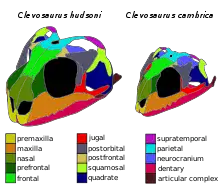
While the grouping of Rhynchocephalia is well supported, the relationships of many taxa to each other are uncertain, varying substantially between studies.[19] In modern cladistics, the clade Sphenodontia includes all rhynchocephalians other than Gephyrosaurus (as well as some other related genera) which has been found to be more closely related to squamates in some analyses.[8] In 2018, two major clades within Sphenodontia were defined, the infraorder Eusphenodontia which is defined by the least inclusive clade containing Polysphenodon, Clevosaurus hudsoni and Sphenodon, which is supported by the presence of three synapomorphies, including the presence of clearly visible wear facets on the teeth of the dentary or maxilla, the premaxillary teeth are merged into a chisel like structure, and the palatine teeth are reduced to a single tooth row, with the presence of an additional isolated tooth. The unranked clade Neosphenodontia (previously informally referred to as the "eupropalinals", in reference to the back and forward motion in the mouth during mastication), is defined as the most inclusive clade containing Sphenodon but not Clevosaurus hudsoni, which is supported by the presence of six synapomorphies, including the increased relative length of the antorbital region of the skull (the part of the skull forward of the eye socket), reaching 1/4 to 1/3 of the total skull length, the posterior (hind) edge of the parietal bone is only slightly curved inward, the parietal foramen is found at the same level or forward of the anterior border of the supratemporal fenestra (an opening of the skull), the palatine teeth are further reduced from the condition in eusphenodontians to a single lateral tooth row, the number of pterygoid tooth rows are reduced to one or none, and the posterior border of the ischium is characterised by a distinctive process.[20] In 2021 the clade Acrosphenodontia was defined, which is less inclusive than Sphenodontia and more inclusive than Eusphenodontia, and includes all sphenodontians with fully acrodont dentition, excluding basal partially acrodont sphenodontians.[21] In 2022 the extinct clade Leptorhynchia was defined, including a variety of aquatically adapted neosphenodontians, characteristed by the elongation of the fourth metacarpal, the presence of a posterior process on the ischium, and the antorbital region of the skulls is between a third and a quarter of the total skull length.[22]
The family Sphenodontidae has been used to include the tuatara and its closest relatives within Rhynchocephalia. However the grouping has lacked a formal definition, with the included taxa varying substantially between analyses.[8] The closest relatives of the tuatara are placed in the clade Sphenodontinae, which are characterised by a completely closed temporal bar.[13]
Paleobiology
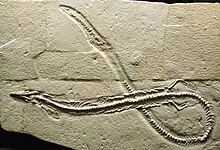
Rhynchocephalians were once considered to be a morphologically conservative group with little diversity. However, discoveries in recent decades have disputed this, finding a wide array of diversity within the clade.[3][16] Early rhynchocephalians possess small ovoid teeth designed for piercing, and were probably insectivores.[23] Amongst the most distinct rhynchocephalians are the pleurosaurs, known from the Jurassic of Europe, which were adapted for marine life, with elongated snake-like bodies with reduced limbs, with the specialised Late Jurassic genus Pleurosaurus having an elongated triangular skull highly modified from those of other rhynchocephalians.[24] Several other lineages of rhyncocephalians have been suggested to have had semi-aquatic habits.[25] Eilenodontines are thought to have been herbivorous, with batteries of wide teeth with thick enamel used to process plant material.[26] The sapheosaurids, such as Oenosaurus and Sapheosaurus from the Late Jurassic of Europe possess broad tooth plates unique amongst tetrapods, and are thought to have been durophagous, with the tooth plates being used to crush hard shelled organisms.[27][8]
Evolutionary history
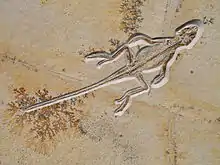
Rhynchocephalia is estimated to have diverged from Squamata between the Middle Permian and earliest Triassic, between 270 and 252 million years ago.[8] The oldest known remains of rhynchocephalians are indeterminate jaw fragments from the Erfurt Formation near Vellberg in Southern Germany, dating to the Ladinian stage of the Middle Triassic, around 238-240 million years old.[1] Rhynchocephalians reached a worldwide distribution across Pangaea by the end of the Triassic, with the Late Triassic-Early Jurassic genus Clevosaurus having 10 species across Asia, Africa, Europe, North and South America.[28] The earliest rhynchocephalians were small animals, but by the Late Triassic the group had evolved a wide range of body sizes.[29] During the Jurassic rhynchocephalians reached their apex of morphological diversity, including specialised herbivorous and aquatic forms.[3] The only record of Rhynchocephalians from Asia are indeterminate remains of Clevosaurus from the Early Jurassic (Sinemurian) aged Lufeng Formation of Yunnan, China. Rhynchocephalians are noticeably absent from younger localities in the region, despite the presence of favourable preservation conditions.[30]
Rhynchocephalians disappeared from North America and Europe after the Early Cretaceous,[31] and were absent from North Africa[32] and northern South America[33] by the early Late Cretaceous. The cause of the decline of Rhynchocephalia remains unclear, but has often been suggested to be due to competition with advanced lizards and mammals.[34] They appear to have remained diverse in high-latitude southern South America during the Late Cretaceous, where lizards remained rare, with their remains outnumbering terrestrial lizards by a factor of 200.[32] An indeterminate rhynchocephalian is known from the latest Cretaceous of Insular India.[35] The youngest known remains of rhynchocephalians outside of New Zealand are those of Kawasphenodon peligrensis from the early Paleocene (Danian) of Patagonia, shortly after the Cretaceous–Paleogene extinction event.[36] Indeterminate sphenodontine jaw fragments bearing teeth are known from the early Miocene (19-16 million years ago) St Bathans fauna, New Zealand, that are indistinguishable from those of the living tuatara. It is unlikely that the ancestors of the tuatara arrived in New Zealand via oceanic dispersal, and it is thought that they were already present in New Zealand when it separated from Antarctica between 80 and 66 million years ago.[34]
Gallery
 Skull reconstruction of Gephyrosaurus a possible basal rhyncocephalian
Skull reconstruction of Gephyrosaurus a possible basal rhyncocephalian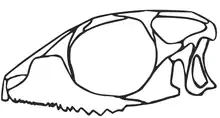 Reconstruction of the skull of Diphydontosaurus a basal member of Sphenodontia
Reconstruction of the skull of Diphydontosaurus a basal member of Sphenodontia Reconstruction of the skulls of Clevosaurus hudsoni (A) and Clevosaurus cambrica (B)
Reconstruction of the skulls of Clevosaurus hudsoni (A) and Clevosaurus cambrica (B)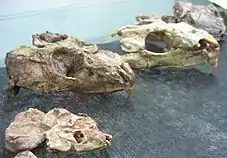 Skulls of Priosphenodon, a herbivorous member of Eilenodontinae
Skulls of Priosphenodon, a herbivorous member of Eilenodontinae Reconstruction of the skull of Priosphenodon in lateral view
Reconstruction of the skull of Priosphenodon in lateral view Reconstruction of the skull of Navajosphenodon, an early member of Sphenodontinae
Reconstruction of the skull of Navajosphenodon, an early member of Sphenodontinae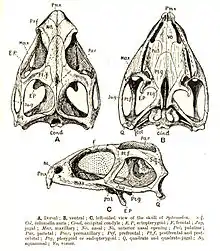 Skull of the tuatara in various views
Skull of the tuatara in various views
Phylogeny
The following is a cladogram of Rhynchocephalia after Rauhut et al., 2012.[27]
| Rhynchocephalia |
| ||||||||||||||||||||||||||||||||||||||||||||||||||||||||||||||||||||||||||||||||||||||||||||||||||||||
References
- Jones ME, Anderson CL, Hipsley CA, Müller J, Evans SE, Schoch RR (September 2013). "Integration of molecules and new fossils supports a Triassic origin for Lepidosauria (lizards, snakes, and tuatara)". BMC Evolutionary Biology. 13: 208. doi:10.1186/1471-2148-13-208. PMC 4016551. PMID 24063680.
- Reynoso VH (2000). "An unusual aquatic sphenodontian (Reptilia: Diapsida) from the Tlayua Formation (Albian), central Mexico". Journal of Paleontology. 74 (1): 133–148. Bibcode:2000JPal...74..133R. doi:10.1017/s0022336000031310. S2CID 232346834.
- Herrera-Flores JA, Stubbs TL, Benton MJ (2017). "Macroevolutionary patterns in Rhynchocephalia: is the tuatara (Sphenodon punctatus) a living fossil?". Palaeontology. 60 (3): 319–328. Bibcode:2017Palgy..60..319H. doi:10.1111/pala.12284. ISSN 1475-4983.
- Fraser N, Sues HD, eds. (1994). "Phylogeny" In the Shadow of the Dinosaurs: Early Mesozoic Tetrapods. Cambridge University Press. ISBN 0-521-45242-2.
- Evans SE, Prasad GV, Manhas BK (November 2001). "Rhynchocephalians (Diapsida: Lepidosauria) from the Jurassic Kota Formation of India". Zoological Journal of the Linnean Society. 133 (3): 309–34. doi:10.1111/j.1096-3642.2001.tb00629.x.
- "Sphenodon". Dictionary.com Unabridged (v 1.1). Random House, Inc. Retrieved 8 January 2007.
- Evans SE, Borsuk-Białynicka M (2009). "A small lepidosauromorph reptile from the Early Triassic of Poland" (PDF). Paleontologica Polonica. 65: 179–202.
- Simões TR, Caldwell MW, Pierce SE (December 2020). "Sphenodontian phylogeny and the impact of model choice in Bayesian morphological clock estimates of divergence times and evolutionary rates". BMC Biology. 18 (1): 191. doi:10.1186/s12915-020-00901-5. PMC 7720557. PMID 33287835.
- "Rhynchocephalians". University College London. Retrieved 2022-08-09.
- Dendy A (1911). "VI. On the structure, development and morphological interpretation of the pineal organs and adjacent parts of the brain in the tuatara ( sphenodon punctatus )". Philosophical Transactions of the Royal Society B. 201 (274–281): 227–331. doi:10.1098/rstb.1911.0006. ISSN 0264-3960.
- Vitt LJ, Caldwell JP (2014). "Chapter 20: Rhynchocephalians (Sphenodontids)". Herpetology. Elsevier. pp. 553–554. doi:10.1016/b978-0-12-386919-7.00020-4. ISBN 978-0-12-386919-7.
- Evans SE, Jones ME (2010). "The Origin, Early History and Diversification of Lepidosauromorph Reptiles". New Aspects of Mesozoic Biodiversity. Lecture Notes in Earth Sciences. Vol. 132. Berlin, Heidelberg: Springer Berlin Heidelberg. pp. 27–44. Bibcode:2010LNES..132...27E. doi:10.1007/978-3-642-10311-7_2. ISBN 978-3-642-10310-0.
- Simões TR, Kinney-Broderick G, Pierce SE (March 2022). "An exceptionally preserved Sphenodon-like sphenodontian reveals deep time conservation of the tuatara skeleton and ontogeny". Communications Biology. 5 (1): 195. doi:10.1038/s42003-022-03144-y. PMC 8894340. PMID 35241764.
- Sanger TJ, Gredler ML, Cohn MJ (October 2015). "Resurrecting embryos of the tuatara, Sphenodon punctatus, to resolve vertebrate phallus evolution". Biology Letters. 11 (10): 20150694. doi:10.1098/rsbl.2015.0694. PMC 4650183. PMID 26510679.
- Jenkins KM, Jones ME, Zikmund T, Boyde A, Daza JD (September 2017). "A Review of Tooth Implantation Among Rhynchocephalians (Lepidosauria)". Journal of Herpetology. 51 (3): 300–306. doi:10.1670/16-146. ISSN 0022-1511. S2CID 90519352.
- Jones ME (August 2008). "Skull shape and feeding strategy in Sphenodon and other Rhynchocephalia (Diapsida: Lepidosauria)". Journal of Morphology. 269 (8): 945–966. doi:10.1002/jmor.10634. PMID 18512698.
- Matsumoto R, Evans SE (January 2017). "The palatal dentition of tetrapods and its functional significance". Journal of Anatomy. 230 (1): 47–65. doi:10.1111/joa.12534. PMC 5192890. PMID 27542892.
- Jones ME, O'higgins P, Fagan MJ, Evans SE, Curtis N (July 2012). "Shearing mechanics and the influence of a flexible symphysis during oral food processing in Sphenodon (Lepidosauria: Rhynchocephalia)". Anatomical Record. 295 (7): 1075–1091. doi:10.1002/ar.22487. PMID 22644955.
- Romo de Vivar PR, Martinelli AG, Schmaltz Hsiou A, Soares MB (2020-07-02). "A New Rhynchocephalian from the Late Triassic of Southern Brazil Enhances Eusphenodontian Diversity". Journal of Systematic Palaeontology. 18 (13): 1103–1126. doi:10.1080/14772019.2020.1732488. ISSN 1477-2019. S2CID 216226211.
- Herrera-Flores JA, Stubbs TL, Elsler A, Benton MJ (2018-04-06). "Taxonomic reassessment of Clevosaurus latidens Fraser, 1993 (Lepidosauria, Rhynchocephalia) and rhynchocephalian phylogeny based on parsimony and Bayesian inference". Journal of Paleontology. 92 (4): 734–742. Bibcode:2018JPal...92..734H. doi:10.1017/jpa.2017.136.
- Chambi-Trowell, Sofia A. V.; Martinelli, Agustín G.; Whiteside, David I.; Vivar, Paulo R. Romo de; Soares, Marina Bento; Schultz, Cesar L.; Gill, Pamela G.; Benton, Michael J.; Rayfield, Emily J. (2021-06-03). "The diversity of Triassic South American sphenodontians: a new basal form, clevosaurs, and a revision of rhynchocephalian phylogeny". Journal of Systematic Palaeontology. 19 (11): 787–820. doi:10.1080/14772019.2021.1976292. hdl:1983/af14affc-a26e-426b-83ca-e1833e355882. ISSN 1477-2019. S2CID 240487298.
- DeMar, David G.; Jones, Marc E. H.; Carrano, Matthew T. (2022-12-31). "A nearly complete skeleton of a new eusphenodontian from the Upper Jurassic Morrison Formation, Wyoming, USA, provides insight into the evolution and diversity of Rhynchocephalia (Reptilia: Lepidosauria)". Journal of Systematic Palaeontology. 20 (1): 1–64. doi:10.1080/14772019.2022.2093139. hdl:2440/136608. ISSN 1477-2019. S2CID 252325953.
- Jones ME (2009). Koppe T, Meyer G, Alt KW, Brook A (eds.). "Dentary Tooth Shape in Sphenodon and Its Fossil Relatives (Diapsida: Lepidosauria: Rhynchocephalia)". Frontiers of Oral Biology. Basel: Karger. 13: 9–15. doi:10.1159/000242382. ISBN 978-3-8055-9229-1. PMID 19828962.
- Klein N, Scheyer TM (February 2017). "Microanatomy and life history in Palaeopleurosaurus (Rhynchocephalia: Pleurosauridae) from the Early Jurassic of Germany". Die Naturwissenschaften. 104 (1–2): 4. Bibcode:2017SciNa.104....4K. doi:10.1007/s00114-016-1427-3. PMID 28005148. S2CID 27133670.
- Bever GS, Norell MA (November 2017). "A new rhynchocephalian (Reptilia: Lepidosauria) from the Late Jurassic of Solnhofen (Germany) and the origin of the marine Pleurosauridae". Royal Society Open Science. 4 (11): 170570. doi:10.1098/rsos.170570. PMC 5717629. PMID 29291055.
- Jones ME, Lucas PW, Tucker AS, Watson AP, Sertich JJ, Foster JR, et al. (June 2018). "Neutron scanning reveals unexpected complexity in the enamel thickness of an herbivorous Jurassic reptile". Journal of the Royal Society, Interface. 15 (143): 20180039. doi:10.1098/rsif.2018.0039. PMC 6030635. PMID 29899156.
- Rauhut OW, Heyng AM, López-Arbarello A, Hecker A (2012). Farke AA (ed.). "A new rhynchocephalian from the late jurassic of Germany with a dentition that is unique amongst tetrapods". PLOS ONE. 7 (10): e46839. Bibcode:2012PLoSO...746839R. doi:10.1371/journal.pone.0046839. PMC 3485277. PMID 23118861.
- Chambi-Trowell SA, Whiteside DI, Benton MJ, Rayfield EJ (November 2020). Lautenschlager S (ed.). "Biomechanical properties of the jaws of two species of Clevosaurus and a reanalysis of rhynchocephalian dentary morphospace". Palaeontology. 63 (6): 919–939. Bibcode:2020Palgy..63..919C. doi:10.1111/pala.12493. S2CID 220902843.
- Herrera-Flores JA, Elsler A, Stubbs TL, Benton MJ (2021). "Slow and fast evolutionary rates in the history of lepidosaurs". Palaeontology. 65. doi:10.1111/pala.12579. ISSN 1475-4983. S2CID 244019684.
- Jones ME (2006). "The Early Jurassic clevosaurs from China (Diapsida: Lepidosauria)". New Mexico Museum of Natural History and Science Bulletin. 37: 548–562.
- Cleary TJ, Benson RB, Evans SE, Barrett PM (March 2018). "Lepidosaurian diversity in the Mesozoic-Palaeogene: the potential roles of sampling biases and environmental drivers". Royal Society Open Science. 5 (3): 171830. Bibcode:2018RSOS....571830C. doi:10.1098/rsos.171830. PMC 5882712. PMID 29657788.
- Apesteguía S, Daza JD, Simões TR, Rage JC (September 2016). "The first iguanian lizard from the Mesozoic of Africa". Royal Society Open Science. 3 (9): 160462. Bibcode:2016RSOS....360462A. doi:10.1098/rsos.160462. PMC 5043327. PMID 27703708.
- Simões TR, Wilner E, Caldwell MW, Weinschütz LC, Kellner AW (August 2015). "A stem acrodontan lizard in the Cretaceous of Brazil revises early lizard evolution in Gondwana". Nature Communications. 6 (1): 8149. Bibcode:2015NatCo...6.8149S. doi:10.1038/ncomms9149. PMC 4560825. PMID 26306778.
- Jones ME, Tennyson AJ, Worthy JP, Evans SE, Worthy TH (April 2009). "A sphenodontine (Rhynchocephalia) from the Miocene of New Zealand and palaeobiogeography of the tuatara (Sphenodon)". Proceedings of the Royal Society B: Biological Sciences. 276 (1660): 1385–90. doi:10.1098/rspb.2008.1785. PMC 2660973. PMID 19203920.
- Anantharaman, S.; DeMar, David G.; Sivakumar, R.; Dassarma, Dilip Chandra; Wilson Mantilla, Gregory P.; Wilson Mantilla, Jeffrey A. (2022-06-30). "First rhynchocephalian (Reptilia, Lepidosauria) from the Cretaceous–Paleogene of India". Journal of Vertebrate Paleontology. 42 (1): e2118059. Bibcode:2022JVPal..42E8059A. doi:10.1080/02724634.2022.2118059. ISSN 0272-4634. S2CID 252558728.
- Apesteguía S, Gómez RO, Rougier GW (October 2014). "The youngest South American rhynchocephalian, a survivor of the K/Pg extinction". Proceedings of the Royal Society B: Biological Sciences. 281 (1792): 20140811. doi:10.1098/rspb.2014.0811. PMC 4150314. PMID 25143041.
Further reading
- Apesteguia S, Rougier GW (2007). "A Late Campanian Sphenodontid Maxilla from Northern Patagonia" (PDF). American Museum Novitates (3581): 1–12. doi:10.1206/0003-0082(2007)3581[1:ALCSMF]2.0.CO;2. Retrieved 2019-03-30.
- Daugherty CH, Cree A, Hay JM, Thompson MB (1990). "Neglected taxonomy and continuing extinctions of tuatara (Sphenodon)". Nature. 347 (6289): 177–179. Bibcode:1990Natur.347..177D. doi:10.1038/347177a0. S2CID 4342765.
- Evans SE (November 2003). "At the feet of the dinosaurs: the early history and radiation of lizards" (PDF). Biological Reviews of the Cambridge Philosophical Society. 78 (4): 513–51. doi:10.1017/S1464793103006134. PMID 14700390. S2CID 4845536.
- Gemmell NJ, Rutherford K, Prost S, Tollis M, Winter D, Macey JR, et al. (August 2020). "The tuatara genome reveals ancient features of amniote evolution". Nature. 584 (7821): 403–409. doi:10.1038/s41586-020-2561-9. PMC 7116210. PMID 32760000.
External links
 Media related to Sphenodontia at Wikimedia Commons
Media related to Sphenodontia at Wikimedia Commons Data related to Rhynchocephalia at Wikispecies
Data related to Rhynchocephalia at Wikispecies